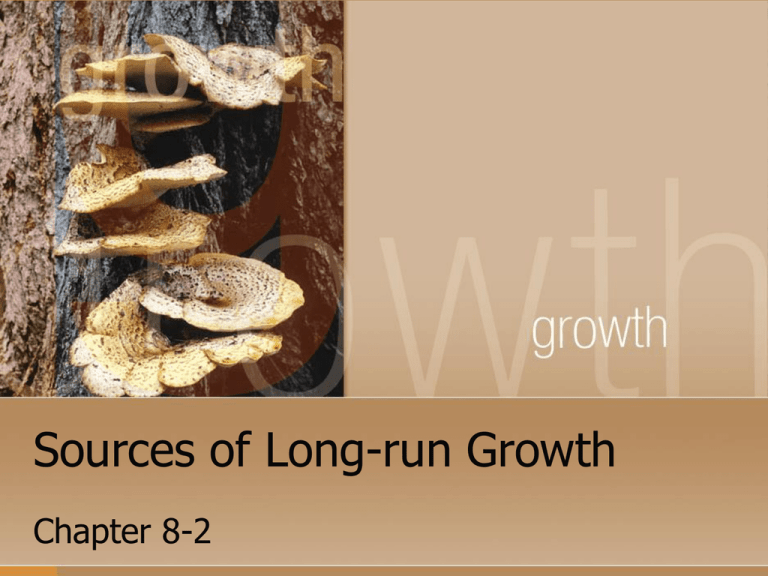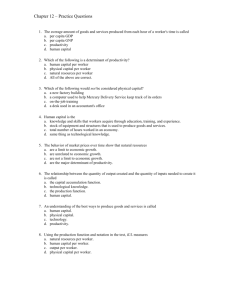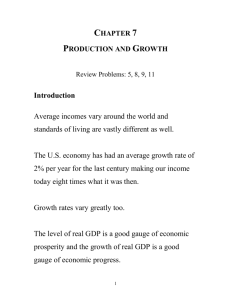8-2source - Rio Hondo Community College Faculty Websites
advertisement

Sources of Long-run Growth Chapter 8-2 Ultimate Source of Growth Long-run growth depends almost entirely on one ingredient: Rising Productivity Productivity Labor productivity, often referred to simply as productivity, is output per worker. Population Growth GDP Per Capita can grow by putting more people to work Large increases in GDP Per Capita must be the result of increased output per worker. GDP Per Capita = GDP / Population Productivity = Real GDP / Number of Workers Explaining Growth in Productivity Physical capital consists of human-made resources such as buildings and machines. Human capital is the improvement in labor created by the education and knowledge embodied in the workforce. Technology is the technical means for the production of goods and services. Retail?! According to McKinsey, major source of productivity improvement after 1995 was a surge in output per worker in retailing—stores were selling much more merchandise per worker. Why? Wal-Mart?!! Wal-Mart has been a pioneer in using modern technology to improve productivity. everyone in the retail business knew about computers, but Wal-Mart figured out what to do with them. a lot of economic growth comes from everyday improvements rather than glamorous new technologies. Accounting for Growth: The Aggregate Production Function The aggregate production function is a hypothetical function that shows how productivity (real GDP per worker) depends on the quantities of physical capital per worker and human capital per worker as well as the state of technology. Diminishing Returns An aggregate production function exhibits diminishing returns to physical capital when, holding the amount of human capital and the state of technology fixed, each successive increase in the amount of physical capital leads to a smaller increase in productivity. Diminishing Returns to Physical Capital Physical Capital and Productivity Growth Accounting Growth accounting estimates the contribution of each major factor in the aggregate production function to economic growth. The amount of physical capital per worker grows 3% a year. According to estimates of the aggregate production function, each 1% rise in physical capital per worker, holding human capital and technology constant, raises output per worker by 1/3 of 1%, or 0.33%. The Production Function Production function shows the relationship between inputs and outputs. Growth is shown by a shift in the production function. Technological Progress & Productivity Growth Pitfalls: It May Be Diminished … But It’s Still Positive It’s important to understand what diminishing returns to physical capital means and what it doesn’t mean. It’s an “other things equal” statement: holding the amount of human capital per worker and the technology fixed, each successive increase in the amount of physical capital per worker results in a smaller increase in real GDP per worker. Pitfalls: Diminished but Positive But this doesn’t mean that real GDP per worker eventually falls as more and more physical capital is added. It’s just that the increase in real GDP per worker gets smaller and smaller, albeit remaining at or above zero. So an increase in physical capital per worker will never reduce productivity. Pitfalls: Diminished but Positive But due to diminishing returns, at some point increasing the amount of physical capital per worker no longer produces an economic payoff: that is, at some point the increase in productivity is so small that it is not worth the cost of the additional physical capital. Diminishing Marginal Productivity The Classical growth model by Thomas Malthus (1798) focused on how diminishing marginal productivity would limit growth. Since the amount of farm land is fixed, diminishing marginal productivity would set in as population grew. The iron law of wages - as output per person declines, at some point available output is no longer sufficient to feed the population. Diminishing Returns and Population Growth Subsistence level of output per worker Output Production function Q2 Q1 L1 L* Labor Natural Resources In contrast to earlier times, in the modern world, natural resources are a much less important determinant of productivity than human or physical capital for the great majority of countries. Japan Vs. Nigeria For example, some nations with very high real GDP per capita, such as Japan, have very few natural resources. Some resource-rich nations, such as Nigeria (which has sizable oil deposits), are very poor. Same Old Same Old Many economists were puzzled by the slowdown in the U.S. growth rate of labor productivity—a fall from an average annual growth rate of 3% in the late 1960s to slightly less than 1% in the mid-1980s. This was surprising given that there appeared to be rapid progress in technology. Why didn’t information technology show large rewards? Changing your ways Paul David suggested that a new technology doesn’t yield its full potential if you use it in old ways. Productivity would take off when people really changed their way of doing business to take advantage of the new technology— such as, replacing letters and phone calls with electronic communications. Sure enough, productivity growth accelerated dramatically in the second half of the 1990…







